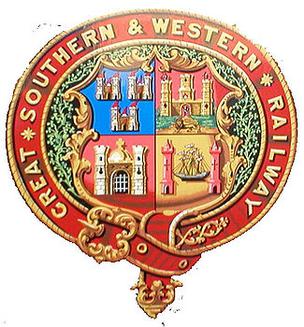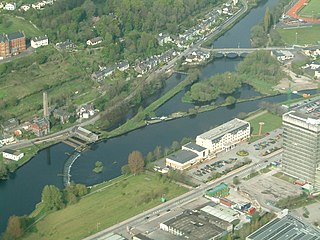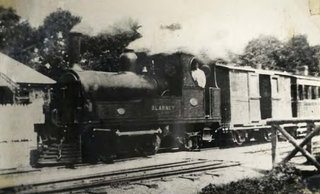Related Research Articles

Connolly station or Dublin Connolly is the busiest railway station in Dublin and Ireland, and is a focal point in the Irish route network. On the North side of the River Liffey, it provides InterCity, Enterprise and commuter services to the north, north-west, south-east and south-west. The north–south Dublin Area Rapid Transit (DART) and Luas red line light rail services also pass through the station. The station offices are the headquarters of Irish Rail, Iarnród Éireann. Opened in 1844 as Dublin Station, the ornate facade has a distinctive Italianate tower at its centre.

Heuston Station, also known as Dublin Heuston, is one of Dublin's largest railway stations and links the capital with the south, southwest and west of Ireland. It is operated by Iarnród Éireann (IÉ), the national railway operator. It also houses the head office of its parent company, Córas Iompair Éireann (CIÉ). The station is named in honour of Seán Heuston, an executed leader of the 1916 Easter Rising, who had worked in the station's offices.

Coachford is a village in County Cork, Ireland. It is located on the north side of the River Lee. The village is located in the civil parish of Magourney. Coachford is part of the Dáil constituency of Cork North-West.

The Great Southern and Western Railway (GS&WR) was an Irish gauge railway company in Ireland from 1844 until 1924. The GS&WR grew by building lines and making a series of takeovers, until in the late 19th and early 20th centuries it was the largest of Ireland's "Big Four" railway networks. At its peak the GS&WR had an 1,100-mile (1,800 km) network, of which 240 miles (390 km) were double track.

Cork, Bandon and South Coast Railway (CB&SCR), was an Irish gauge railway in Ireland. It opened in 1849 as the Cork and Bandon Railway (C&BR), changed its name to Cork Bandon and South Coast Railway in 1888 and became part of the Great Southern Railway (GSR) in 1924.

The Tralee and Dingle Light Railway and Tramway was a 32 mi (51 km), 3 ft narrow gauge railway running between Tralee and Dingle, with a 6.2 mi (10.0 km) branch from Castlegregory Junction to Castlegregory, in County Kerry on the west coast of Ireland. It operated between 1891 and 1953; the Castlegregory branch closed shortly prior to the outbreak of the Second World War. It was one of the most westerly railway lines in Europe, but the terminus of the Valentia Harbour branch at 10.277785° was further west.

Turners Cross is a ward on the south side of Cork City in Ireland, and home to the Roman Catholic parish of the same name.

Tower, Ordnance Survey Ireland name Model Village, is a village within the administrative area of Cork city in Ireland. It is located to the northwest of the city, approximately 3 km from the town of Blarney on the R617 road. Together with Blarney, Tower is a satellite or dormitory town of Cork city. Tower is part of the Dáil constituency of Cork North-Central. As of the 2022 census of Ireland, the village had a population of 3,300.

Limerick railway station also known as Colbert Station or Limerick Colbert serves the city of Limerick in County Limerick, Ireland. It is on Parnell Street and is the main station on the Limerick Suburban Rail network. It has approximately 2,500 rail passengers a day travelling on four rail routes. The Bus Éireann bus station on site services approximately one million passengers a year, with 125 buses departing each day.

InterCity is the brand name given to rail services operated by Iarnród Éireann that run between Dublin and other major cities in Ireland. InterCity branding is also used in other European countries by unaffiliated organizations.

The Dublin–Cork Main Line is the main InterCity railway route in Ireland between Dublin Heuston and Cork Kent. In 2018, 3.46 million passengers travelled on the line, a 10% increase from 2017 figures.

The Carrigrohane Straight is a straight segment of road that stretches for 2.75 miles (4.43 km), from the edge of Cork west to Carrigrohane in County Cork, Ireland. It is just over 140 years old, and now forms part of the N22 National Primary route between Cork and Tralee.

The Schull and Skibbereen Railway was a minor narrow gauge railway in County Cork, Ireland. It opened in 1886 and closed in 1947. The track gauge was a 3 ft narrow gauge. The formal name of the company was The West Carberry Tramways and Light Railways Company Ltd.

The Cork and Muskerry Light Railway was a 3 ft narrow gauge railway in County Cork, Ireland. The first part of the railway opened in 1887 and closed in 1934. A major reason for building the railway was to exploit tourist traffic to Blarney Castle.
The Cork City Railways were constructed in 1911 and opened in 1912 to connect the Irish standard gauge systems north and south of the River Lee in Cork, Ireland.

Cork Albert Quay railway station was on the Cork, Bandon and South Coast Railway in County Cork, Ireland.
Coachford railway station was on the Cork and Muskerry Light Railway in County Cork, Ireland.
Tower Bridge railway station was on the Cork and Muskerry Light Railway in County Cork, Ireland. It served the village of Tower until its closure in 1934.

Blarney railway station was a terminus station on the Cork and Muskerry Light Railway (CMLR) in County Cork, Ireland. The station served Blarney, and was located on the south side of the town's main square, with Blarney Castle a short walk to the south west.

The Cork and Macroom Direct Railway (CMDR) was an Irish gauge railway in Ireland which ran the 24 miles (39 km) from Cork to Macroom.
References
- ↑ Butt, R.V.J. (1995). The Directory of Railway Stations. Patrick Stephens Ltd. p. 64. ISBN 1-85260-508-1.
- ↑ "Coachford Junction" (PDF). Railscot - Irish Railways. Retrieved 7 May 2012.